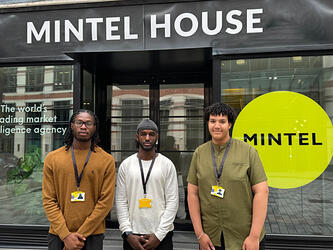Being prepared: The future of foresight

In a volatile world, strategic foresight can help organisations to become more agile, resilient and better equipped to manage risks and capitalise on opportunities.
While insight makes sense of what we know, explaining and optimising the present, foresight is about anticipating the future. But what is foresight’s core purpose (prediction or preparedness?) and how can we turn it into action within organisations? What is the role of consumer insight in the future of foresight?
These were key themes for exploration at a November roundtable co-hosted by MRS in partnership with strategic foresight consultancy Next Up, which sponsored the event.
To reflect varying perspectives, participants were invited from both public and private sector organisations and from within foresight and insight. The discussion was held under Chatham House rule.
Priming the conversation in a brief introduction, event co-host Josh McBain, joint founder and chief executive, Next Up, highlighted the “growing sense of energy” around foresight, fuelled by “the state of permanent crisis that many companies feel they’ve been in”.
“From Covid-19 through to the Ukraine war, and now Trump 2.0, we've definitely seen an acceleration in spend, focus and interest in foresight as a practice,” he said. “With that investment has come growing accountability and a question of, ‘how do you drive activation?’”
He also noted there are “more companies seeking to create a better balance between supply- and demand-side focus areas – and making connections between them”.
The purpose of foresight
One fundamental question is how we define the role of foresight – today and in the future – and where it should sit within organisations.
In a pre-event poll, attendees were asked: “How confident are you that foresight inside your organisation currently has a clear purpose, mandate and recognised value?”. No one claimed to be “very confident”. While the majority ( 83%) said they were “somewhat confident”, 17% reported that foresight’s role was “unclear/nascent.”
When asked whether their organisations see foresight’s role as being about prediction or preparation, the results were also mixed: half said it was “primarily about prediction”, while 33% said it was “primarily about preparation” – and 17% reported “unclear expectations”.
During the roundtable discussion, however, it became apparent that use of foresight to enable preparedness trumps the value of prediction alone.
“In the automotive industry, prediction has led to frustration around things like battery electric vehicle adoption rates in consumers,” explained one roundtable participant. “Our approach to strategic foresight steers away from that singular line that gives a sense of false confidence.
“We’re pushing towards scenario building, wind tunnelling – trying to intercept the processes that lead to strategic options – and against that prediction space.”
“Preparation is the chief thing,’ asserted another attendee. “In an uncertain world, you can't know what you don't know.” They added that when something negative hits an organisation, “better preparation for how you handle it – with a clearer narrative and strategy” – creates confidence through its response.
As one foresight professional concluded: “Foresight is about building a range of mitigation plans that you might never have to use, so that when something does happen, there’s some internal institutional awareness of how to respond.”
Having influence and impact
There was general agreement that foresight’s audience has broadened from innovation and risk to corporate strategy and other key stakeholders throughout the business.
Being based within strategy clearly optimises overall influence. “We sit next to our corporate strategy colleagues who are responsible for taking those big strategic bets and options to the board,’ explained one foresight professional. “We like having an influence and helping them to game out different scenarios and thoughtful futures.”
“There are pro and cons,” interjected a second participant. “We’re part of an early innovation team which means we’re well integrated within long-term innovation, but not so well connected to strategy. “That sometimes means the top-down push is missing for decisions – but if we were sitting in strategy, we wouldn't be connected to the pipelines.”
Another attendee simply noted: “I think it’s about where foresight has the most impact and what the organisation is using it for.”
Impact, of course, relies on foresight being acted upon. In the pre-event poll, 83% reported only “moderate” success when asked “how effectively does foresight in your organisation turn into real decision-making or action?” while 17% admitted their influence was weak.
Most foresight professionals find that a “high-agency” approach is needed to get action taken.
“I've started emailing senior people and saying, ‘do you want this?’,” reported one member of the roundtable group. “Initially, I was in the mindset of ‘I'm going to wait to be asked’. But no one asks; though if you offer it, they say, “we’d love that’.”
The individual added that where advice is generated but not acted upon it equates to shouting into the void.“We have a KPI for our team: Grade D is, ‘we do some work, and nobody reads it’. Grade C is, ‘lots of people read it; they say it’s great’. Grade B is where maybe ‘less people read it, but the ones that have talk about it in meetings’. Grade A is ‘we can tangibly point to a conversation where they decided to do something’. And if we don't get Grade A, we're hard on ourselves.”
“Foresight is about building mitigation plans that you might never have to use, so that when something does happen, there’s awareness of how to respond.”
Having ‘sales targets’ for foresight teams was highlighted as an innovative way of ensuring that members go beyond writing reports and are invested in outcomes. However, foresight professionals may struggle to define their purpose to decision-makers – or even to themselves.
“It’s a relatively young discipline and it lacks a language,” noted one participant. “We find it difficult to articulate the process in a meaningful way, because there are no foundational steps. People project into it whatever they want it to be.”
Linking messages to potential outcomes through tailored, people-centred storytelling is the best way to be heard – and “successful foresight is a two-way movement,” emphasised one attendee. “It’s about the operational delivery from the ground up and strategic decision-making from the top down. When trying to get people invested, a lot of it lies in answering the question, ‘what’s in it for me?’.”
Supporting the application of foresight is also crucial. As one practitioner pointed out: “Sometimes people are a bit lost, saying ‘I get that it’s important but I don't understand what it means to me specifically’.”
Insight’s role in the future of foresight
With a growing need for foresight to decode the future customer, insight has the potential to play a central role.
However, when attendees were asked “how effective are current consumer insight approaches in anticipating future consumer behaviour or attitudinal change?”, 50% reported their effectiveness as “limited: mostly backward-looking or short term, with little real foresight value”.
Current insight approaches can be bounded by data silos, skill gaps and a focus on short-term trends. “One bit of feedback from our senior leadership team was ‘you spend too much time looking back and not enough time looking forward’,” admitted one participant.
This could be addressed by fostering a corporate culture of exploration which draws on agile and inclusive research methodologies capable of informing both foresight and immediate business needs; for example, leveraging advanced analytics, AI and real-time data.
Rather than receiving separate insight and foresight, decision-makers would benefit from holistic, actionable insights that help them to look further ahead – from “now” to “next” to “future”.
“Compartmentalisation is unhelpful,” stressed one member of the group.
Acknowledging this as an opportunity in her closing round-up, MRS managing director Debrah Harding emphasised the potential for joined-up thinking.
“Today’s discussion has reinforced that when we talk about foresight, insight, research, we’re talking about professionalism that has many similarities and alignments,” she said.

We hope you enjoyed this article.
Research Live is published by MRS.
The Market Research Society (MRS) exists to promote and protect the research sector, showcasing how research delivers impact for businesses and government.
Members of MRS enjoy many benefits including tailoured policy guidance, discounts on training and conferences, and access to member-only content.
For example, there's an archive of winning case studies from over a decade of MRS Awards.
Find out more about the benefits of joining MRS here.













0 Comments